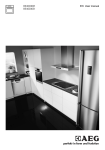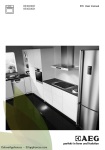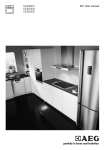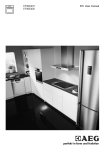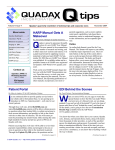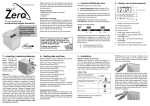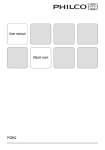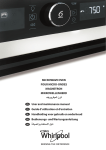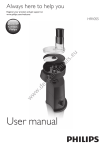Download User manual Oven POB79
Transcript
User manual Oven POB79 2 CONTENTS Safety information Safety instructions Product description Before first use Daily use Clock functions Using the accessories 2 3 5 6 6 7 8 Additional functions Helpful hints and tips Care and cleaning What to do if… Installation Environment concerns 9 9 14 17 17 20 Subject to change without notice. SAFETY INFORMATION Before the installation and use of the appliance, carefully read the supplied instructions. The manufacturer is not responsible if an incorrect installation and use causes injuries and damages. Always keep the instructions with the appliance for future reference. Children and vulnerable people safety Warning! Risk of suffocation, injury or permanent disability. • This appliance can be used by children aged from 8 years and above and persons with reduced physical, sensory or mental capabilities or lack of experience and knowledge if they are supervised by an adult or a person who is responsible for their safety. • Do not let children play with the appliance. • Keep all packaging away from children. • Keep children and pets away from the appliance when it operates or when it cools down. Accessible parts are hot. • If the appliance has a child safety device, we recommend that you activate it. • Cleaning and user maintenance shall not be made by children without supervision. General Safety • Internally the appliance becomes hot when in operation. Do not touch the heating elements that are in the appliance. Always use oven gloves to remove or put in accessories or ovenware. • Do not use a steam cleaner to clean the appliance. 3 • Before maintenance cut the power supply. • Do not use harsh abrasive cleaners or sharp metal scrapers to clean the glass door since they can scratch the surface, which may result in shattering of the glass. • To remove the shelf supports first pull the front of the shelf support and then the rear end away from the side walls. Install the shelf supports in the opposite sequence. SAFETY INSTRUCTIONS Installation Warning! Only a qualified person must install this appliance. • Remove all the packaging. • Do not install or use a damaged appliance. • Obey the installation instruction supplied with the appliance. • Always be careful when you move the appliance because it is heavy. Always wear safety gloves. • Do not pull the appliance by the handle. • Keep the minimum distance from the other appliances and units. • Make sure that the appliance is installed below and adjacent safe structures. • The sides of the appliance must stay adjacent to appliances or to units with the same height. Electrical connection Warning! Risk of fire and electrical shock. • All electrical connections should be made by a qualified electrician. • The appliance must be earthed. • Make sure that the electrical information on the rating plate agrees with the power supply. If not, contact an electrician. • Always use a correctly installed shockproof socket. • Do not use multi-plug adapters and extension cables. • Make sure not to cause damage to the mains plug and to the mains cable. Contact the Service or an electrician to change a damaged mains cable. • Do not let mains cables to come in touch with the appliance door, specially when the door is hot. • The shock protection of live and insulated parts must be fastened in such a way that it cannot be removed without tools. • Connect the mains plug to the mains socket only at the end of the installation. Make sure that there is access to the mains plug after the installation. • If the mains socket is loose, do not connect the mains plug. • Do not pull the mains cable to disconnect the appliance. Always pull the mains plug. • Use only correct isolation devices: line protecting cut-outs, fuses (screw type fuses removed from the holder), earth leakage trips and contactors. • The electrical installation must have an isolation device which lets you disconnect the appliance from the mains at all poles. The isolation device must have a contact opening width of minimum 3 mm. Use Warning! Risk of injury, burns or electric shock or explosion. • Use this appliance in a household environment. • Do not change the specification of this appliance. • Make sure that the ventilation openings are not blocked. • Do not let the appliance stay unattended during operation. • Deactivate the appliance after each use. 4 • Be careful, when you open the appliance door while the appliance is in operation. Hot air can release. • Do not operate the appliance with wet hands or when it has contact with water. • Do not apply pressure on the open door. • Do not use the appliance as a work surface or as a storage surface. • Always keep the appliance door closed when the appliance is in operation. • Open the appliance door carefully. The use of ingredients with alcohol can cause a mixture of alcohol and air. • Do not let sparks or open flames to come in contact with the appliance when you open the door. • Do not put flammable products or items that are wet with flammable products in, near or on the appliance. Warning! Risk of damage to the appliance. • To prevent damage or discoloration to the enamel: – Do not put ovenware or other objects in the appliance directly on the bottom. – Do not put aluminium foil directly on the bottom of the appliance. – do not put water directly into the hot appliance. – do not keep moist dishes and food in the appliance after you finish the cooking. – be careful when you remove or install the accessories. • Discoloration of the enamel has no effect on the performance of the appliance. It is not a defect in the sense of the warranty law. • Use a deep pan for moist cakes. Fruit juices cause stains that can be permanent. Care and Cleaning Warning! Risk of injury, fire or damage to the appliance. • Before maintenance, deactivate the appliance and disconnect the mains plug from the mains socket. • Make sure the appliance is cold. There is the risk that the glass panels can break. • Replace immediately the door glass panels when they are damaged. Contact the Service. • Be careful when you remove the door from the appliance. The door is heavy! • Clean regularly the appliance to prevent the deterioration of the surface material. • Remaining fat or food in the appliance can cause fire. • Clean the appliance with a moist soft cloth. Only use neutral detergents. Do not use abrasive products, abrasive cleaning pads, solvents or metal objects. • If you use an oven spray, obey the safety instructions on the packaging. • Do not clean the catalytic enamel (if applicable) with any kind of detergent. Internal light • The type of light bulb or halogen lamp used for this appliance, is only for household appliances. Do not use it for house lighting. Warning! Risk of electrical shock. • Before replacing the lamp, disconnect the appliance from the power supply. • Only use lamps with the same specifications. Disposal Warning! Risk of injury or suffocation. • Disconnect the appliance from the mains supply. • Cut off the mains cable and discard it. • Remove the door catch to prevent children and pets to get closed in the appliance. 5 PRODUCT DESCRIPTION 1 13 2 3 4 5 6 7 8 5 4 3 2 1 9 10 11 12 1 2 3 4 5 6 7 8 9 10 11 12 13 Control panel Knob for the oven functions Power lamp / symbol Electronic programmer Knob for the temperature Temperature lamp / symbol / indicator Heating element Lamp Fan Rear wall heating element Bottom heat Shelf support, removable Shelf positions Accessories Wire shelf For cookware, cake tins, roasts. Grill- / Roasting pan To bake and roast or as a pan to collect fat. Trivet • For roasting and grilling. Use the trivet only with the Grill- / roasting pan. 6 BEFORE FIRST USE Warning! Refer to the Safety chapters. Initial Cleaning • Remove all parts from the appliance. • Clean the appliance before first use. Important! Refer to chapter "Care and Cleaning". Setting the time You must set the time before you operate the oven. When you connect the appliance to the electrical supply or after a power cut, the indicator for the Time function flashes. Press the + or - button to set the correct time. After approximately five seconds, the flashing stops and the display shows the time of day you set. When you change the time, you must not set the Duration or End ) function at the same time. DAILY USE Warning! Refer to the Safety chapters. To use the appliance, press the control knob. The control knob comes out. Activating and deactivating the appliance 1. Turn the control knob for the oven functions to select an oven function. 2. Turn the control knob for the temperature to select a temperature. 3. To deactivate the appliance turn the control knobs for the oven functions and temperature to the off position. Knob symbol, indicator or lamp (depends on the model - refer to the product description): • The indicator comes on when the oven heats up. • The lamp comes on when the appliance operates. • The symbol shows whether the knob controls one of the cooking zones, the oven functions or the temperature. Oven Functions Oven function Light True Fan Cooking Defrost Fast Grilling Turbo Grilling Application To activate the oven lamp without a cooking function. To bake on the maximum temperature on three oven levels at the same time. When you use this function, decrease the oven temperature by 20 - 40 °C from the standard temperatures you use for Conventional Cooking. Also to dry food. To defrost frozen food. To grill flat food in large quantities, and to toast. To roast larger joints of meat or poultry on one level. Also to gratinate, and to brown. 7 Electronic programmer 1 2 3 hr min 6 5 1 2 3 4 5 6 Function indicators Time display Function indicator Button + Selection button Button - 4 CLOCK FUNCTIONS Clock function Time of day Minute minder Duration End Application To show, set, or change the time. To set a countdown time. This function has no effect on the operation of the oven. To set the length of an oven operation. To set the switch-off time for an oven function. You can use Duration and End at the same time if you want the appliance to activate and deactivate autoand matically: first set the Duration then the End . Setting the clock functions hr min 3. Press + or - to set the necessary clock function. The display shows the indicator for the clock function you set. When the set time ends, the indicator flashes and an acoustic signal sounds for two minutes. With the Duration and End functions, the appliance deactivates automatically. 4. Press a button to stop the signal. 5. Turn the knob for the oven functions and the knob for the temperature to the off position. Cancelling the clock functions 1. For Duration and End, set an oven function and temperature. This is not necessary for the Minute Minder. 2. Press the Selection button again and again until the indicator for the necessary clock function flashes. 1. Push the Selection button again and again until the necessary function indicator flashes. 2. Push and hold the button -. After some seconds the clock function goes out. 8 USING THE ACCESSORIES Warning! Refer to the Safety chapters. Inserting the oven accessories The deep pan and the wire shelf have side edges. These edges and the shape of the guide-bars are a special device to prevent the cookware from slipping. Installing the wire shelf and the deep pan together Put the wire shelf on the deep pan. Push the deep pan between the guide-bars of one of the oven levels. Trivet and Grill- / Roasting pan Warning! Be careful when you remove the accessories from a hot appliance. There is a risk of burns. You can use the trivet to roast larger pieces of meat or poultry on one shelf position: • Put the trivet into the deep pan so that the supports of the wire shelf point up. • Put the deep pan into the oven on the necessary shelf position. 9 You can use the trivet to grill flat dishes in large quantities and to toast: • Put the trivet into the deep pan so that the supports of the wire shelf point down. • Put the deep pan into the oven on the necessary shelf position. ADDITIONAL FUNCTIONS Cooling fan When the appliance operates, the cooling fan activates automatically to keep the surfaces of the appliance cool. If you deacti- vate the appliance, the cooling fan can continue to operate until the appliance cools down. HELPFUL HINTS AND TIPS The temperature and baking times in the tables are guidelines only. They depend on the recipes and the quality and quantity of the ingredients used. Baking General instructions • Your new oven can bake or roast differently to the appliance you had before. Adapt your usual settings (temperature, cooking times) and shelf positions to the values in the tables. • With longer baking times, you can deactivate the oven approximately 10 minutes before the end of the baking time and then use the residual heat. When you cook frozen food, the trays in the oven can twist during baking. When the trays become cold again, the distortions are gone. How to use the Baking Tables • The manufacturer recommends that you use the lower temperature the first time. • If you cannot find the settings for a special recipe, look for the one that is almost the same. • You can extend baking times by 10 – 15 minutes if you bake cakes on more than one level. • Cakes and pastries at different heights do not always brown equally at first. If this occurs, do not change the temperature setting. The differences equalize during the baking procedure. Tips on baking Baking results Possible cause Remedy The bottom of the cake is not browned sufficiently. The shelf position is incorrect. Put the cake on a lower shelf. The cake sinks and becomes soggy, lumpy or streaky. The oven temperature is too high. The next time you bake, set a slightly lower oven temperature. The baking time is too short. Set a longer baking time. You cannot decrease baking times by setting higher temperatures. The cake sinks and becomes soggy, lumpy or streaky. 10 Baking results Possible cause Remedy There is too much liquid in the mixture. Use less liquid. Be careful with mixing times, especially if you use a mixing machine. The cake is too dry. The oven temperature is too low. The next time you bake, set a higher oven temperature. The cake is too dry. The baking time is too long. The next time you bake, set a shorter baking time. The cake browns unevenly. The oven temperature is too high and the baking time is too short. Set a lower oven temperature and a longer baking time. The cake browns unevenly. The mixture is unevenly distributed. Spread the mixture evenly on the baking tray. The cake is not ready in the baking time given. The oven temperature is too low. The next time you bake, set a slightly higher oven temperature. The cake sinks and becomes soggy, lumpy or streaky. Baking on one level: Baking in tins Type of baking Oven function Shelf position Temperature (°C) Time (min) Ring cake or brioche True Fan Cooking 1 150 - 160 50 - 70 Madeira cake / fruit cakes True Fan Cooking 1 140 - 160 70 - 90 Fatless sponge cake True Fan Cooking 2 140 - 150 35 - 50 1) Flan base - short pastry True Fan Cooking 2 Flan base - sponge mixture True Fan Cooking 2 150 - 170 20 - 25 Apple pie (2 tins Ø 20cm, diagonally off set) True Fan Cooking 2 160 60 - 90 170 - 180 10 - 25 1) Preheat the oven Cakes / pastries / breads on baking trays Type of baking Oven function Shelf position Temperature (°C) Time (min) Cake with crumble topping (dry) True Fan Cooking 3 150 - 160 20 - 40 Fruit flans (made with yeast dough / sponge mixture) 1) True Fan Cooking 3 150 35 - 55 Fruit flans made with short pastry True Fan Cooking 3 160 - 170 40 - 80 Oven function Shelf position Temperature (°C) Time (min) Short pastry biscuits True Fan Cooking 3 150 - 160 10 - 20 Short bread / Pastry Stripes True Fan Cooking 3 140 20 - 35 1) Use deep pan Biscuits Type of baking 11 Oven function Shelf position Temperature (°C) Time (min) Biscuits made with sponge mixture True Fan Cooking 3 150 - 160 15 - 20 Pastries made with egg white, merungues True Fan Cooking 3 80 - 100 120 - 150 Macaroons True Fan Cooking 3 100 - 120 30 - 50 Biscuits made with yeast dough True Fan Cooking 3 150 - 160 20 - 40 Puff pastries True Fan Cooking 3 170 - 180 ) 20 - 30 Type of baking ) 10 - 25 20 - 35 Rolls True Fan Cooking 3 160 Small cakes (20 per tray) True Fan Cooking 3 150 ) Multileveled Baking Cakes / pastries / breads on baking trays True Fan Cooking Shelf position Type of baking Temperature (°C) Time (min) 2 shelf positions 3 shelf positions Cream puffs / Eclairs 1/4 - 160 - 180 1) 25 - 45 Dry streusel cake 1/4 - 150 - 160 30 - 45 Temperature (°C) Time (min) 1) Preheat the oven. Biscuits / small cakes / small cakes / pastries / rolls True Fan Cooking Type of baking Shelf position 2 shelf positions 3 shelf positions Short pastry biscuits 1/4 1/3/5 150 - 160 20 - 40 Short bread / Short bread / Pastry Stripes 1/4 1/3/5 140 25 - 50 Biscuits made with sponge mixture 1/4 - 160 - 170 25 - 40 Biscuits made with egg white / Meringues 1/4 - 80 - 100 130 - 170 Macaroons 1/4 - 100 - 120 40 - 80 Biscuits made with yeast dough 1/4 - 160 - 170 30 - 60 Puff pastries 1/4 - 170 - 180 1) 30 - 50 Rolls 1/4 - 180 30 - 55 12 True Fan Cooking Type of baking Shelf position Temperature (°C) Time (min) 2 shelf positions 3 shelf positions 1/4 - 1501) 25 - 40 Oven function Shelf position Temperature (°C) Time (min) Vegetables au gratin 1) Turbo Grilling or True Fan Cooking 1 160 - 170 15 - 30 Baguettes topped with melted cheese Turbo Grilling or True Fan Cooking 1 160 - 170 15 - 30 Stuffed vegetables Turbo Grilling or True Fan Cooking 1 160 - 170 30 - 60 Small cakes / Small cakes (20 per tray) 1) Preheat the oven. Bakes and gratins Dish 1) Preheat the oven Roasting Roasting dishes • Use heat-resistant ovenware to roast (refer to the instructions of the manufacturer). • You can roast large roasting joints directly in the deep pan (if present) or on the wire shelf above the deep pan. • Roast lean meats in the roasting tin with the lid. This keeps the meat more succulent. • All types of meat that can be browned or have crackling can be roasted in the roasting tin without the lid. Roasting with Turbo Grilling Beef Type of meat Quantity Oven function Shelf position Temperature °C Time min. Roast beef or fillet: rare per cm. of thickness Turbo Grilling 1 190 - 200 1) 5-6 Roast beef or fillet: medium per cm. of thickness Turbo Grilling 1 180 - 190 1) 6-8 Roast beef or fillet: well done per cm. of thickness Turbo Grilling 1 170 - 180 1) 8 - 10 Type of meat Quantity Oven function Shelf position Temperature °C Time min. Shoulder, neck, ham joint 1 - 1.5 kg Turbo Grilling 1 160 - 180 90 - 120 Chop, spare rib 1 - 1.5 kg Turbo Grilling 1 170 - 180 60 - 90 Meat loaf 750 g - 1 kg Turbo Grilling 1 160 - 170 50 - 60 Pork knuckle (precooked) 750 g - 1 kg Turbo Grilling 1 150 - 170 90 - 120 1) Preheat the oven Pork Veal 13 Type of meat Quantity Oven function Shelf position Temperature °C Time min. Roast veal 1 kg Turbo Grilling 1 160 - 180 90 - 120 Knuckle of veal 1.5 - 2 kg Turbo Grilling 1 160 - 180 120 - 150 Type of meat Quantity Oven function Shelf position Temperature °C Time min. Leg of lamb, roast lamb 1 - 1.5 kg Turbo Grilling 1 150 - 170 100 - 120 Saddle of lamb 1 - 1.5 kg Turbo Grilling 1 160 - 180 40 - 60 Quantity Oven function Shelf position Temperature °C Time min. Poultry portions 200 - 250 g each Turbo Grilling 1 200 - 220 30 - 50 Half chicken 400 - 500 g each Turbo Grilling 1 190 - 210 35 - 50 Chicken, poulard 1 - 1.5 kg Turbo Grilling 1 190 - 210 50 - 70 Duck 1.5 - 2 kg Turbo Grilling 1 180 - 200 80 - 100 Goose 3.5 - 5 kg Turbo Grilling 1 160 - 180 120 - 180 Turkey 2.5 - 3.5 kg Turbo Grilling 1 160 - 180 120 - 150 Turkey 4 - 6 kg Turbo Grilling 1 140 - 160 150 - 240 Type of meat Quantity Oven function Shelf position Temperature °C Time min. Whole fish 1 - 1.5 kg Turbo Grilling 1 210 - 220 40 - 60 Lamb Poultry Type of meat Fish (steamed) Defrosting Remove the food packaging, and then put the food on a plate. Do not cover it with a bowl or a plate, as this can extend the defrost time. Use the first oven shelf position from the bottom. Defrosting time (min.) Further defrosting time (min.) Chicken, 1000 g 100 - 140 20 - 30 Put the chicken on an upturned saucer placed on a large plate. Turn halfway through. Meat, 1000 g 100 - 140 20 - 30 Turn halfway through. Meat, 500 g 90 - 120 20 - 30 Turn halfway through. Trout, 150 g 25 - 35 10 - 15 - Strawberries, 300 g 30 - 40 10 - 20 - Butter, 250 g 30 - 40 10 - 15 - Dish Comment 14 Dish Defrosting time (min.) Further defrosting time (min.) 80 - 100 10 - 15 60 60 Cream, 2 x 200 g Gateau, 1400 g Cream can also be whipped when still slightly frozen in places. - appliance door and let the appliance cool down. After that, complete the drying process. Drying - True Fan Cooking Use baking parchment as a cover for the oven shelves. For best results, deactivate the appliance halfway through the operation. Open the Vegetables Food to be dried Comment Shelf position 1 level 2 levels Temperature (°C) Beans 3 1/4 60 - 70 6- 8 Peppers 3 1/4 60 - 70 5-6 Vegetables for sour 3 1/4 60 - 70 5-6 Mushrooms 3 1/4 50 - 60 6-8 Herbs 3 1/4 40 - 50 2-3 1 level 2 levels Temperature (°C) Time (h) Plums 3 1/4 60 - 70 8 - 10 Apricots 3 1/4 60 - 70 8 - 10 Apple slices 3 1/4 60 - 70 6-8 Pears 3 1/4 60 - 70 6-9 Time (h) Fruit Food to be dried Shelf position Information on acrylamides Important! According to the newest scientific knowledge, if you brown food (specially the one which contains starch), acrylamides can pose a health risk. Thus, we recommend that you cook at the lowest temperatures and do not brown food too much. CARE AND CLEANING Warning! Refer to the Safety chapters. Notes on cleaning: • Clean the front of the appliance with a soft cloth with warm water and a cleaning agent. • To clean metal surfaces, use a usual cleaning agent. • Clean the appliance interior after each use. Then you can remove dirt more easily and it does not burn on. • Clean stubborn dirt with a special oven cleaner. • Clean all accessories after each use and let them dry. Use a soft cloth with warm water and a cleaning agent. • If you have nonstick accessories, do not clean them using aggressive agents, sharp-edged objects or a dishwasher. It can cause damage to the nonstick coating. 15 Shelf supports Removing the shelf supports You can remove the shelf supports to clean the side walls. 1. Pull the front of the shelf support away from the side wall. 2. Pull the rear end of the shelf support away from the side wall and remove it. 2 1 Installing the shelf supports Install the shelf supports in the opposite sequence. Important! Valid for telescopic runners: The retaining pins on the telescopic runners must point to the front. Lamp Warning! There is a risk of electrical shock. The lamp and the lamp glass cover can be hot. Before you change the lamp: • Deactivate the appliance. • Remove the fuses from the fuse box or deactivate the circuit breaker. Caution! Put a cloth on the bottom of the interior of the appliance. It prevents damage to the lamp glass cover and the cavity. Always use the same lamp type. Replacing the lamp at the cavity ceiling: 1. Turn the lamp glass cover counterclockwise to remove it. 2. Clean the glass cover. 3. Replace the lamp with a suitable 300 °C heat-resistant lamp. 4. Install the glass cover. Oven ceiling You can fold down the heating element on the oven ceiling to clean the oven ceiling easily. Warning! Deactivate the appliance before you fold down the heating element. Make sure that the appliance is cold. There is a risk of burns. Folding down the heating element 1. Remove the shelf supports. 16 3. Pull it forwards against the spring pressure and out along the supports on the two sides. 4. The heating element folds down. You can clean the oven ceiling. Installing the heating element 1. Install the heating element in the opposite sequence. 2. Hold the heating element with two hands at the front. Important! Install the heating element correctly above the supports on the inner walls of the appliance. 2. Install the shelf supports. Cleaning the oven door Removing the door and the glass panels You can remove the oven door and the internal glass panels to clean it. The number of glass panels is different for different models. Warning! Be careful when you remove the door from the appliance. The door is heavy. A A 1. Open the door fully. 2. Fully press the clamping levers (A) on the two door hinges. 3. Close the oven door to the first opening position (approximately 70° angle). 4. Hold the door with one hand on each side and pull it away from the appliance at an up angle. 5. Put the door with the outer side down on a soft cloth on a stable surface. This is to prevent scratches. 6. Hold the door trim (B) on the top edge of the door at the two sides and push inwards to release the clip seal. 7. Pull the door trim to the front to remove it. 2 B 1 17 8. Hold the door glass panels on their top edge one by one and pull them up out of the guide. 9. Clean the glass panel with water and soap. Dry the glass panel carefully. Installing the door and the glass panels above steps in the opposite sequence. Install the smaller panel first, then the larger. When the cleaning is completed, install the glass panels and the oven door. Do the WHAT TO DO IF… Warning! Refer to the Safety chapters. Problem Possible cause Remedy The appliance does not heat up. The appliance is deactivated. Activate the appliance. The appliance does not heat up. The clock is not set. Set the clock. The appliance does not heat up. The necessary settings are not set. Control the settings. The appliance does not heat up. The fuse is released. Make sure that the fuse is the cause of the malfunction. If the fuse releases again and again, contact a qualified electrician. The lamp does not operate. The lamp is defective. Replace the lamp. Steam and condensation settle on the food and in the appliance cavity. You left the dish in the appliance for too long. Do not leave the dishes in the oven for longer than 15 - 20 minutes after the cooking process ends. The display shows “12.00”. A power cut. Reset the clock. If you cannot find a solution to the problem yourself, contact your dealer or the service centre. The necessary data for the service centre is on the rating plate. The rating plate is on the front frame of the appliance cavity. We recommend that you write the data here: Model (MOD.) ......................................... Product number (PNC) ......................................... Serial number (S.N.) ......................................... INSTALLATION Warning! Refer to the Safety chapters. Important! The built-in unit must meet the stability requirements of DIN 68930. 18 min. 3 mm min. 50 mm = = 19 560 min. 600 548 20 min. ! 546 114 530 min. 594 572 30 579 5 567 594 21 200 cm2 548 546 590 560 min. 20 530 min. 572 114 594 579 5 590 min. 567 594 21 30 20 alternativ 100 max. R1200 mm 130 140 H05VV-F H05RR-F min. 1600 mm 90º 2x3,5x25 ENVIRONMENT CONCERNS The symbol on the product or on its packaging indicates that this product may not be treated as household waste. Instead it should be taken to the appropriate collection point for the recycling of electrical and electronic equipment. By ensuring this 21 product is disposed of correctly, you will help prevent potential negative consequences for the environment and human health, which could otherwise be caused by inappropriate waste handling of this product. For more detailed information about recycling of this product, please contact your local council, your household waste disposal service or the shop where you purchased the product. Packaging material The packaging material is environmentally-friendly and recyclable. Plastic parts are marked with international abbreviations such as PE, PS, etc. Dispose of the packaging material in the containers provided for this purpose at your local waste management facility. 22 23 892956692-A-362012
























